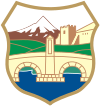Čair Municipality
Municipality of Čair
Општина Чаир Komuna e Çairit | |
|---|---|
City municipality (Urban) | |
 Flag  Coat of arms | |
 | |
| Coordinates: 42°0′7″N 21°26′17″E / 42.00194°N 21.43806°ECoordinates: 42°0′7″N 21°26′17″E / 42.00194°N 21.43806°E | |
| Country | |
| Region | |
| Municipality | |
| Municipal seat | Skopje |
| Government | |
| • Mayor | Visar Ganiu (DUI) |
| Area | |
| • Total | 3.52 km2 (1.36 sq mi) |
| Population | |
| • Total | 64,773 |
| • Density | 18,400/km2 (48,000/sq mi) |
| Time zone | UTC+1 (CET) |
| Website | Official Website |
Čair (Macedonian: ![]() Чаир (help·info), Albanian: Komuna e Çairit) is one of the ten municipalities that make up the City of Skopje, the capital of the Republic of North Macedonia.[1] The municipal administration consists of a council and mayor.[1] Skopje's old town is located in Čair.[2][3] The municipality has a predominantly Albanian population.[2][4]
Чаир (help·info), Albanian: Komuna e Çairit) is one of the ten municipalities that make up the City of Skopje, the capital of the Republic of North Macedonia.[1] The municipal administration consists of a council and mayor.[1] Skopje's old town is located in Čair.[2][3] The municipality has a predominantly Albanian population.[2][4]
Geography[]
Čair is located along the northern (left) bank of the Vardar River, opposite the modern city center. It borders Centar Municipality to the southwest, Karpoš Municipality to the west, Butel Municipality to the north, and Gazi Baba Municipality to the east.
History[]
Skopje's old town, or Stara Čaršija, had been the city's main center[2][3] at least since the 12th century. Turkish influence is dominant in the Stara Čaršija. Due to five centuries of Ottoman rule the old town is still filled with Ottoman style buildings, narrow cobblestone walkways and many mosques.[2] Next to the Old Bazaar is Bit Pazar, Skopje's largest market that has retained its multi-ethnic and multi-lingual environment where rural people come to sell farming produce and locals conduct business.[5]
Čair is historically a multi-ethnic area.[6] In the aftermath of the 2001 insurgency some Macedonians from Čair moved to other Skopje urban areas such as nearby Butel in the north or to southern Macedonian neighbourhoods where there is an availability of public infrastructure.[6] Čair municipality prior to 2004 was larger and included Butel municipality within its boundaries that has a majority Macedonian population (48.60%), followed by Albanians (38.89%), Turks (4.12%), Bosniaks (3.40%), Romani (1.46%) and Serbs (2.11%).[7] The new territorial-administrative reform of 2004 divided the municipal unit into a smaller Čair municipality with an Albanian majority (57.01%) and a separate Butel municipality with a Macedonian majority.[7] The new boundaries of Čair municipality resulted in the loss of its industrial zone to Butel municipality which previously provided most of the revenue for the Čair municipal budget.[8]
In the Macedonian elections of March 2005, Izet Mexhiti, a member of the Albanian political party Democratic Union for Integration (DUI) became the mayor of Čair municipality.[9] A coalition between DUI and the Macedonian Social Democratic Union of Macedonia (SDSM) was formed in the municipal council while other smaller Albanian and Macedonian parties were also represented.[10] In 2006 the municipal council adopted a new flag and coat of arms that displayed Skanderbeg, the Old Bazaar and the Ottoman clock tower (Saat kula) that did not have the support of Macedonian counselors.[10]
Skanderbeg Square is located in Čair. In the late 2000s a statue of Skanderbeg commemorating the medieval Albanian warrior was installed in an open space at the front entrance to the Old Bazaar by Čair municipality.[11] During the 2010s, Čair Municipality and ethnic Albanians living in the Macedonian capital refurbished the space into a second city square as part of a rival project to the government's “Skopje 2014” revamp scheme which excluded investments for the area.[12][13][14] Political negotiation between Albanian and Macedonian elites resulted in the Macedonian Government funding most of the refurbishment of Skanderbeg Square.[15]
On 26 November 2019, an earthquake struck Albania and Čair Municipality held 3 days of mourning in solidarity with the earthquake victims.[16]
Demographics[]

Čair has a mixed population that includes minorities of Romani and Turks, yet the neighborhood is associated with Albanians in North Macedonia.[6] In the modern era relations between ethnic groups in Čair Municipality remain cordial.[8]
According to the last national census from 2002, Čair has 64,773 inhabitants.[8][17] Ethnic groups in the municipality include:
- Albanians = 36,921 (57.0%)
- Macedonians = 15,628 (24.1%)
- Turks = 4,500 (6.9%)
- Roma = 3,083 (4.8%)
- Bosniaks = 2,950 (4.6%)
- others = 1,691 (2.6%)
External links[]
| Wikimedia Commons has media related to Čair Municipality. |
Sports[]
Macedonian football's top tier side KF Shkupi plays its home games at Čair Stadium.
Notes[]
- ^ Jump up to: a b Ragaru 2008, pp. 542–543.
- ^ Jump up to: a b c d Poposki, Zoran; Todorova, Marija (2016). "Public Memory in Post-Conflict Skopje:Civic Art as Resistance to Narratives of Ethnicity and Disintergration". In O'Rawe, Des; Phelan, Mark (eds.). Post-conflict performance, film and visual arts: Cities of memory. Palgrave Macmillan. p. 99. ISBN 9781137439550.
- ^ Jump up to: a b Véron 2017, p. 118.
- ^ Dimova, Rozita (2013). Ethno-Baroque: Materiality, Aesthetics and Conflict in Modern-Day Macedonia. Berghahn Books. p. 133. ISBN 9781782380412.
- ^ Véron 2017, pp. 130, 133–134.
- ^ Jump up to: a b c Ragaru 2008, p. 536.
- ^ Jump up to: a b Ragaru 2008, pp. 536–537.
- ^ Jump up to: a b c Ragaru 2008, p. 537.
- ^ Ragaru 2008, pp. 537–538.
- ^ Jump up to: a b Ragaru 2008, p. 538.
- ^ Ragaru, Nadege (2008). "The Political Uses and Social Lives of "National Heroes": Controversies over Skanderbeg's Statue in Skopje". Südosteuropa. 56 (4): 528–529, 531–532, 539–540, 545–549, 540–542, 549–550.
- ^ Sinisa Jakov Marusic (27 September 2010). "Skopje's Albanians Plan 'Alternative' City Square". Skopje: Balkan Insight. Retrieved 2 March 2018.
- ^ Mattioli, Fabio (2014). "Regimes of Aesthetics: Competing Performances Surrounding the Skopje 2014 Plan". In Petrović, Tanja (ed.). Mirroring Europe: ideas of Europe and europeanization in Balkan societies. Brill. p. 75. ISBN 9789004275089.
- ^ Lyon, Aisling (2015). Decentralisation and the Management of Ethnic Conflict: Lessons from the Republic of Macedonia. Routledge. p. 161. ISBN 9781317372042.
- ^ Véron, Ophélie (2017). "Challenging Neoliberal Nationalism in Urban Space: Transgressive Practices and Spaces in Skopje". In Erdi, Gülçin; Şentürk, Yıldırım (eds.). Identity, Justice and Resistance in the Neoliberal City. Palgrave Macmillan. p. 126. ISBN 9781137586322.
- ^ "Komunat shqiptare në Maqedoni anulojnë kremtimet për festat e nëntorit" (in Albanian). Gazeta Express. 27 November 2019. Archived from the original on 28 November 2019. Retrieved 29 November 2019.
- ^ 2002 census results in English and Macedonian (PDF)
- Čair Municipality
- Municipalities of North Macedonia
- Municipalities of Skopje
- Albanian communities in North Macedonia

